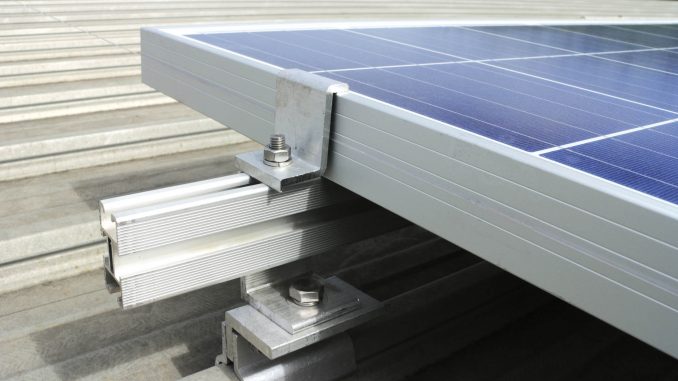
The solar photovoltaic (PV) segment has emerged as a lucrative market in recent years. It has seen a sharp drop in module prices and witnessed significant capacity addition, both in India and overseas. Significant improvements have also been made in the efficiency of panels, and the design and technology of other components. While solar modules are the key component of a solar power system, other components such as mounting structures are also being looked at for technology innovation.
Mounting structures are used to mount panels at an appropriate angle and provide structural support. They are typically fabricated from stainless steel, either hot dipped galvanised steel or pre-galvanised cold rolled steel. These structures must be designed such that they are tall enough to withstand flooding conditions and strong enough to withstand strong winds. In addition, improvisations may be needed based on the geographical and environmental conditions of the project site.
Material consideration
In a solar PV plant, panels are installed on the ground or on rooftops using mounting structures that support their weight and position, and provide the freedom to move at various angles for generating maximum power. While selecting the material for mounting structures, two important factors should be kept in mind, the outdoor location and 25-year lifespan of panels. At outdoor locations, the system is exposed to harsh weather conditions such as rain and strong winds for long periods of time. This can lead to a breakdown of the structure, loss of strength and material degradation. In order to ensure efficient functioning of the system through its lifespan, the material used for mounting structures should be durable, sturdy, corrosion resistant and lightweight. The light weight helps in easier transportation and installation of the structure.
The industry has experimented with different materials for mounting structures, ranging from wood-based ones to professionally engineered frames using aluminium, steel and galvanised steel. For the past few years, steel has been the most preferred material for mounting structures. This is mainly because of its stiffness, durability and ease of customisation properties. While it can meet a wind load of 100 miles per hour with ease, the durability of steel can be further improved by galvanising it with zinc.
In recent times, companies have also started installing mounting structures made of aluminium. While it is more expensive than steel, it offers benefits such as lower weight, high stability, high resistance to corrosion, greater mouldability and easier maintenance. It also entails lower life cycle costs in comparison to steel.
In addition to metal-based structures, polymers are also being used for making mounting structures. Polymers are artificially synthesised using a range of materials to obtain varying properties. For mounting structures, polymers with high strength, light weight, weather resistance, corrosion resistance, wear and tear resistance, heat resistance and easy mouldability can be utilised. The main polymers used in the solar industry are polyethylene, acrylonitrile styrene acrylate, and a blend of polyphenylene oxide and polystyrene. While they are currently more expensive as compared to other materials, they may become relevant in the future with technological improvement and economies of scale.
Based on the location and type of the plant, as well as labour and time availability, different materials can be utilised to make mounting structures. For instance, steel mounting structures may be better suited for regions with high wind speed, while the aluminium ones may be used for rooftop plants. At present, steel is the most widely used material for constructing mounting structures based on the large share of utility-scale plants in India.
Challenges
The major challenges that the mounting structure industry is experiencing are the infiltration of quick-fix design concepts with excessive leaning towards cost-cutting, manufacturing bottlenecks due to excise duty uncertainty and steady transformation of the industry into a buyers’ market.
Every project site is unique and mounting structures have to be customised according to the loading parameters that the site is subject to. Adopting a standard design for all locations, although convenient, will lead to the system performing at a sub-par level. While every market player is focusing on design optimisation to better suit the project needs, a huge push towards cost-cutting is adversely impacting the market. Cost reduction at the expense of plant longevity can cause long-term damages to the segment.
Cost trends
With the increasing share of solar power in the power sector, a downward trend in the price of the entire solar PV system has been observed. Module prices have fallen significantly in recent years and the focus is now shifting towards optimising the cost of balance of system components, including mounting structures.
The presence of a large number of players in the segment has already resulted in cost reduction as well as design improvements. As per the Central Electricity Regulatory Commission’s (CERC) benchmark norms for solar PV projects, mounting structure costs have shown a similar trend. From Rs 10.5 million per MW in 2013-14, they have come down to Rs 3.5 million per MW in 2016-17.
Design developments
In order to suit project needs and reduce costs, market players are looking at developing new designs, and improvising on the existing products through material replacement and structural changes. In this regard, the elimination of rails in mounting structures has been observed. While rails provide durability and support to modules, rail-less systems can reduce installation costs owing to low labour requirement. At present, the cost of rail-mounted systems is lower than that of rail-less structures. However, going forward, the cost of rail-less products is expected to come down and the industry may witness a complete replacement of railed products with rail-less products. Two new racking systems, integrated racking and direct-attachment racking, have been introduced in the market. In the former, racks are built into module frames while in the latter, the racks are directly installed on roofs with specialised mounts and without rails.
New markets
Apart from the conventional ground-mounted and rooftop-mounted solar PV systems, new ideas for system installations are being taken up. The installation of solar PV panels on trains is one such example. In early January 2017, a solar-powered coach of Southern Railways’ Jan Shatabdi Express was flagged off. Built at a cost of Rs 0.39 million, the 4.6 kW system comprises 16 solar panels of 300 Watts each. These panels can power 34 fans and 56 lights in each coach and help the railways save about 1,700 litres of diesel per annum per coach.
The entire system was mounted on a specifically designed metallic structure to withstand wind velocity, and the impact of vibration and shock on the train. The satisfactory performance of this coach will pave the way for operating a full train with solar panel-powered coaches. Considering Indian Railways’ large network, there is huge scope for the adoption of specially designed mounting structures on railway coaches. Further, solar car parking, canal-top and floating solar PV projects may become popular in the future. In this respect, market players should be ready to improvise and innovate on their current products to meet the market requirements.
Conclusion
The mounting structure market, along with the entire solar PV industry, is likely to grow at a fast pace going forward. With the current focus on the utility-scale industry, the market will be crowded with steel-based, ground-mounted structures until a radical change takes place in the technology and cost of polymer mounting structures. Meanwhile, the industry is expected to continue innovating on the design and material aspect of mounting structures in order to serve new areas of solar power development and provide further cost reductions in the segment.




